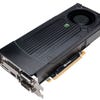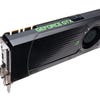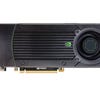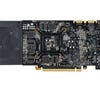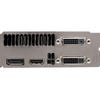NVIDIA GeForce GTX 670 Review
Does the second-tier Kepler offer better value for money than a 680?
Silicon chip production is not an exact art - no two chips that come off the production line are exactly alike. Some are capable of running at faster speeds than others, while sometimes defects manifest when the transistors aren't fabricated entirely as they should be, owing to microscopic imperfections in the material. So what happens to these less-than-perfect chips? Well, a process called "binning" sorts the processors into various quality levels, each destined for different end-products.
In the case of the NVIDIA graphics cards based on the new "Kepler" line, the best processors are reserved for the top-end product - the GTX 680, which received a rapturous review from Digital Foundry last month. Now, with the debut of the newer, cheaper GTX 670, we begin to see what happens with the rest of the production run.
The usual form for NVIDIA's tier-two product is to cut down the design of the flagship in every meaningful way: fewer active processor cores running at a slower speed, a more restricted memory bus, and slower RAM. In this way, more of the processors produced at the production facility become viable. In the past, enthusiasts and hackers alike have been successful in reactivating some of the disabled features - though often they don't work, since the chips are not of the highest quality.
The GTX 670 is intriguing in that NVIDIA has been somewhat conservative with the cutbacks. Indeed, some might argue that it has been overly generous: of the eight "SMX" units in the GTX 680 (each unit containing 192 CUDA cores), only one of them has been disabled. The 2GB of onboard GDDR5 memory still runs at the same bogglingly fast 6GHz, and there have been no compromises with the bus, which remains at 256-bit. We do see a modest reduction in processor speed: the base 1006MHz clock speed is reduced down to 915MHz, while the auto-overclocking "GPU Boost" technology maxes out at 980MHz up against the GTX 680's 1050MHz.
So, to put it plainly - what we have here is 87.5 per cent of the available processor power running at 90 to 93 per cent of the speed. Bearing in mind how preposterously fast the GTX 680 was, this level of compromise should make for an excellent, cheaper alternative.
"The GTX 670 has 87.5 per cent of the 680's CUDA cores running at 90 to 93 per cent of the speed. With the 256-bit bus and ultra-fast 6GHz RAM retained, the new card should be very special."
The product shots above are of the NVIDIA reference design, which is the exact unit that was supplied for review. Just like the GTX 680 it only requires two six-pin PCI Express power inputs rather than the eight pin/six pin set-up seen in the old Fermi cards (GTX 460, 480 etc) and power requirements are significantly reduced from 195W down to 170W - that's a saving of almost 50W from the old GTX 570, and over 70W from the GTX 580, a card that gets demolished in both benchmarks and gameplay performance tests.
Also interesting is that the PCB for the GTX 670 is significantly cut down in terms of length, though a plastic "spacer" is in place that makes overall dimensions almost identical to the GTX 680 - this is presumably to accommodate the substantial cooling assembly. In terms of fan noise, the new card remains fairly quiet but the GTX 680 seems to have a better quality, almost silent fan. On our card a kind of high-pitched whirr could be heard when the GTX 670 was under heavy load.
Turning to the rear of the card, ports and functionality appears to be completely identical to the top-end single-GPU Kepler: we have two dual-link DVI sockets, Display Port and HDMI. Just like its stable-mate, the GTX 670 is capable of running four displays simultaneously - for those with the cash to spare it runs three stereo 3D displays with a single screen to spare for utility apps (voice chat for example) to operate concurrently with your gameplay.
GTX 670: Performance Analysis
We repeated the same series of tests we undertook when we reviewed the GTX 680, covering off both synthetic and game-based benchmarks and the all-important gameplay analysis. This gives us a couple of interesting comparisons. Firstly we can quantify how well the new card compares against the more expensive product, and secondly we can also see how the GTX 670 ranks alongside the old flagship GTX 580, which is available for around £30 less than the new card. We would have relished the opportunity to put the new product up against the top-end Radeon HD cards, but unfortunately AMD could not provide review samples.
The test rig remains unchanged: we have a Core i7 920 Nehalem chip overclocked from its standard 2.66GHz up to a more worthy 3.33GHz, and it's backed by 9GB of DDR3 RAM. The operating system is of course the 64-bit iteration of Windows 7. In short then, plenty of horsepower on tap which should help ensure that the GPU is never starved of data.
Let's kick off with some benchmarks - as good a way as any of ascertaining what this piece of kit is theoretically capable of achieving.
Futuremark 3DMark 11: Tested on standard Performance and Extreme settings.
"3DMark11 results suggest that the GTX 670 blitzes the outgoing GTX 580 in terms of performance with both cards now selling at ballpark price-points."
| GTX 580 (Perf) | GTX 670 (Perf) | GTX 680 (Perf) | GTX 580 (Extreme) | GTX 670 (Extreme) | GTX 680 (Extreme) | |
|---|---|---|---|---|---|---|
| Graphics Score | 6219 | 8836 | 9100 | 1914 | 2650 | 2875 |
| Physics Score | 6559 | 7304 | 7436 | 6142 | 7372 | 7433 |
| Combined Score | 6181 | 6631 | 6718 | 2555 | 3187 | 3446 |
| 3DMark 11 Score | P6263 | P7962 | P8512 | X2112 | X2883 | X3117 |
In Futuremark's 3DMark11 720p performance benches, the GTX 670 outperformed the GTX 580 by 27 per cent, while offering 93 per cent of the GTX 680's performance. In the Extreme testing scenario, results were arguably even better - a 36 per cent boost in overall score compared to the GTX 580, and 92 per cent of the score achieved by the top-end GTX 680. The overall conclusion is striking - we still see a big boost over the old NVIDIA headliner while retaining the vast majority of the power of the most powerful single-GPU card on the market.
Next up, another benchmarking stable - Unigine Heaven Benchmark 3.0 engaged at its punishing DirectX 11 best, running with all settings ramped up to the absolute maximum.
Unigine Heaven Benchmark 3.0 Basic: DX11, 1920x1080, 8xAA, high shaders, high textures, trilinear filtering, anisotropy x16, occlusion enabled, refraction enabled, volumetric enabled, tessellation extreme.
"The Unigine bench suggests that the GTX 670 offers around 93 per cent of the 680's power, at just 75 per cent of the price."
| GTX 580 | GTX 670 | GTX 680 | |
|---|---|---|---|
| Average FPS | 34.9 | 42.9 | 46.1 |
| Min FPS | 17.5 | 21.9 | 22.6 |
| Max FPS | 91.4 | 107.7 | 116.1 |
| Unigine Score | 880 | 1082 | 1162 |
Unigine ties in quite closely with 3DMark11, with the card achieving average frame-rates and overall scores suggesting that it offers 93 per cent of the performance of the GTX 680, with the final mark representing an impressive 23 per cent boost over the GTX 580.
In our GTX 680 review we were somewhat disappointed to see that the Metro 2033 benchmarking tool provided no actual performance boost whatsoever for NVIDIA's new Kepler technology. Frame-rates were basically identical to the GTX 580, and so it comes as no surprise to see that the tier-two Kepler once again provides identical performance.
Metro 2033 Frontline Benchmark: DX11, 1920x1080, very high quality, 4x MSAA, AF 4x anisotropy, advanced PhysX enabled, tessellation Enabled, depth-of-field enabled.
| GTX 580 | GTX 670 | GTX 680 | |
|---|---|---|---|
| Min FPS | 9.86 | 6.29 | 10.21 |
| Max FPS | 53.71 | 54.62 | 54.36 |
| Average FPS | 27.03 | 27.33 | 27.80 |
With the built-in benchmarking tool found in Batman: Arkham City, the GTX 680 did manage to comprehensively best its predecessor with a 35 per cent boost in performance on max settings with PhysX disabled, and a 20 per cent increase with the hardware physics acceleration set to the "normal" level.
Intriguingly, the GTX 670 mirrors the performance of its stable-mate very, very closely. Aside from a couple of dips that bring down minimum frame-rate, overall averages turn out to be the same - a very pleasing turn of events.
Batman: Arkham City Benchmark: DX11, 1920x1080, 8x MSAA, high tessellation, very high detail, all other settings enabled.
"The in-game Arkham City benchmarking test suggests that in some applications, the GTX 670 may well offer almost identical performance to its more expensive stable-mate."
| GTX 580 (PhysX normal) | GTX 670 (PhysX normal) | GTX 680 (PhysX normal) | GTX 580 (PhysX off) | GTX 670 (PhysX off) | GTX 680 (PhysX off) | |
|---|---|---|---|---|---|---|
| Average FPS | 42 | 51 | 50 | 53 | 71 | 72 |
| Min FPS | 20 | 18 | 20 | 26 | 16 | 15 |
| Max FPS | 56 | 74 | 73 | 72 | 100 | 99 |
Overall conclusions from this battery of tests are highly encouraging. It suggests that the GTX 670 retains most of the performance boost over the older GTX 580 in synthetic benchmarks, with the Metro 2033 and Batman tests offering the tantalising possibility that in actual gameplay it could well be the equal of the more expensive card.
So let's put that directly to the test with our assessment of the card's performance in gaming conditions.
Gameplay Analysis
In these tests, our objectives are remarkably straightforward - we want to see how this hardware performs in what we would define as ideal gaming conditions. Quality presets are set to the maximum levels, but we have v-sync engaged in order to present the best-possible image consistency and to eliminate screen-tear completely.
This presents two issues for measuring GPU performance. As we're assessing results from a 60Hz output, frame-rate is capped at 60 frames per second - games often run a lot, lot faster than that depending on what's being rendered on-screen. The thing is, when they do, you get screen-tear on a 60Hz screen - not ideal and something we'd prefer to avoid.
The second problem is that when the 16.67ms rendering budget is exceeded, the GPU effectively stalls until the next screen-refresh, introducing stutter. It's precisely for this reason that NVIDIA introduced Adaptive V-Sync - something we see all the time on consoles where v-sync is dropped when rendering runs over budget. However, at this price point, we're interested in solid image consistency with no tearing whatsoever so the adaptive tech remains switched off in these tests.
Beginning with Battlefield 3, set to 1080p with all settings maxed out at the Ultra level, there's a small variation in frame-rate in some sections with the GTX 680 offering an extra 4FPS to 8FPS in like-for-like situations. However, the overall experience across the run of play is remarkably similar. Factoring in how much cheaper the GTX 670 is, it's really hard to recommend the higher-end card for what is to all intents and purposes the same gameplay experience. Up against the old GTX 580, the new card retained most of the performance boost, with anything up to a 12FPS advantage - now that is a noticeable improvement.
"The differences between the GTX 670 and 680 are very small across the run of play in DICE's epic Battlefield 3, suggesting we're just an option tweak or two away from parity."
Next up, the awesome power of Crysis 2, running in Direct X 11 mode with all settings at the Ultra level and the high-resolution texture pack installed. Before we talk about results, it's perhaps worth pointing out just what a revelatory increase in quality this game represents over the console versions - the difference is as pronounced as Battlefield 3, and a strong example of just how far ahead in terms of rendering PC gaming can be. The improved visuals are stunning, the effects work is superlative and the notion that we can have this running at 1080p at 60 frames per second is testament to both the Crytek tech team and the GPU engineers behind the latest cutting-edge hardware.
We noted that performance has increased significantly since the arrival of revised Kepler drivers, and overall frame-rates are now much more sustained around the 60FPS mark, with only intensive effects work causing any kind of noticeable dip. The overall gameplay experience between the two high-end NVIDIA cards is essentially the same - amazing stuff. Curiously, in some cases the GTX 670 seemed smoother than its higher-end sibling. We're talking about just a handful of dropped frames here so this could be background tasks impacting on game performance, but it's odd nonetheless.
Our final analysis sees us return to another of Crytek's masterpieces - Crysis Warhead. It remains a brilliant game but hails from an era where optimisation was not such a major focus for the Frankfurt-based developers. As we saw in our GTX 680 review, with 4x multi-sampling anti-aliasing (MSAA) engaged, CryEngine 2 is an enormous resource hog to the point where no single graphics card is capable of running Crysis at a sustained 1080p60, or anything even approaching it.
Results from this test were fairly predictable, similar to the Battlefield 3 analysis. In exact like-for-like rendering situations (engine-driven cut-scenes), Crysis Warhead runs around 4FPS faster on the GTX 680. Frame-rate drops caused by cut-scene transitions and bringing up new UI elements (such as the binoculars) show equal hits to performance, suggesting this is not a GPU issue.
What is apparent from the non-synchronised battle scene at the end of the video is that the higher-end card does seem to be better equipped for sustaining performance when the engine is under considerable stress.
"While the GTX 670 acquitted itself beautifully in Crysis 2, the older Crysis Warhead presented immense difficulties at max settings with nothing like a sustained 1080p60 performance."
NVIDIA GeForce GTX 670: The Digital Foundry Verdict
The GTX 680 is a phenomenal graphics card and is still King of the Hill, but factoring in price points, this second-tier product actually seems to be the better buy.
The raw numbers are compelling: based on a quick survey, the cheapest GTX 670 available now costs £318, compared to the least expensive GTX 680 at £430. Meanwhile, the outgoing former champ - the GTX580 - is available new for £305.
The bottom line is that the GTX 670 offers an impressive 20 per cent boost over the older model for just £13 more, while providing the vast majority of the GTX 680's performance with a hefty £112 saving. On top of that, as Anandtech has demonstrated, an overclock often sees you matching and even exceeding the performance of NVIDIA's top-end single GPU offering.
"The GTX 680 is still King of the Hill, but factoring in value, this second tier product actually seems to be the better buy."
However, even at stock settings, it's still possible to produce a nigh-on identical gameplay experience in many cases, simply because a rule of diminishing returns applies to a great many of the quality settings found in a lot of games. If you've spent £300 on a graphics card, of course you'll want to ramp up everything to the max - if anything, it helps make you feel you're getting your money's worth. However, the difference between "high" and "ultra" on certain tweakables can mean a profound effect on GPU usage, with only a marginal increase to actual image quality. If frame-rate's your bag, in many cases, you could be just one or two optional tweaks away from matching GTX 680 performance without ever having to go near an overclocking control panel.
The GTX 670 has other charms too. We were impressed with the power efficiency of this cut-down Kepler - a mere 170W consumption for this level of performance is an excellent achievement bearing mind that the GTX 580 could suck down an incredible 250W from the mains. As both our benchmarks and our gameplay tests affirm, the older card isn't just more power hungry - it can't get anywhere near this new product in terms of performance.
It all bodes well for the upcoming GTX 660 (or whatever it ends up being called) - the mainstream graphics card that will replace the stalwart GTX 560ti. Here's where NVIDIA has its work cut-out for it. AMD has dominated here with the Radeon HD 6870, while the newer 7870 and 7850 cards also offer great performance at good price points. If NVIDIA can beat their performance at the same price with this level of power efficiency, it would be a stunning achievement. We'll report back on this as soon as we have a review card in our possession...


